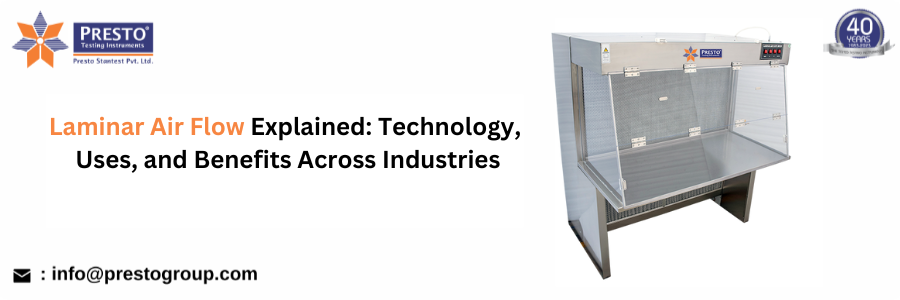Introduction to Laminar Air Flow
Laminar air flow (LAF) is a crucial technology in various industries that require contamination-free environments. It ensures a unidirectional flow of air at a uniform velocity to prevent particulate contamination. This technology is widely used in laboratories, hospitals, and manufacturing units to maintain a sterile workspace.
What is Laminar Air Flow?
Laminar air flow refers to the controlled flow of filtered air in a single direction to maintain sterility. It eliminates airborne contaminants by passing air through High-Efficiency Particulate Air (HEPA) or Ultra-Low Penetration Air (ULPA) filters before it enters the workspace.
Laminar Air Flow Principle
The fundamental principle of laminar air flow is to maintain a constant, unidirectional airflow at a uniform velocity to minimize turbulence and airborne contamination. It follows these key principles:
- HEPA Filtration: Air passes through high-efficiency particulate air (HEPA) filters, which remove 99.97% of particles as small as 0.3 microns.
- Constant Airflow: The air moves in a single direction—either horizontally or vertically—ensuring a clean environment.
- Turbulence Prevention: The uniform flow prevents cross-contamination and the accumulation of airborne particles.
Laminar Air Flow Uses
Laminar air flow is essential in various fields due to its contamination-control capabilities. Its primary uses include:
- Microbiological Studies: Used in research and testing environments to prevent contamination.
- Pharmaceutical Manufacturing: Ensures drug production in a sterile atmosphere.
- Food Industry: Maintains hygiene standards in packaging and quality control.
- Hospitals and Healthcare: Used in operation theaters, intensive care units (ICUs), and sterile processing.
- Electronics and Semiconductor Manufacturing: Helps prevent damage to microcircuits caused by airborne particles.
Laminar Air Flow Diagram
A laminar air flow diagram visually represents how air moves within the unit. It typically includes the position of HEPA filters, fans, and air intake/exhaust points.
Laminar Air Flow Chamber
A laminar air flow chamber is a closed cabinet that provides a contamination-free environment by continuously filtering the air. These chambers are widely used in:
- Medical research – Handling sterile specimens.
- Microbiology – Growing cultures free from contamination.
- Pharmaceuticals – Preparing sterile drug formulations.
Components of a laminar air flow chamber include:
- Workbench
- HEPA/ULPA filters
- UV sterilization light
- Airflow control system
Application of Laminar Air Flow
Laminar air flow finds applications in various sectors, including:
- Medical Research: Ensuring sterility in biological experiments.
- Pharmaceuticals: Manufacturing sterile drugs and formulations.
- Microbiology Laboratories: Culturing and handling of bacteria or cells without contamination.
- Electronics and Semiconductor Manufacturing: Preventing dust from affecting microprocessors.
- Tissue Culture Labs: Providing a contaminant-free environment for growing plant cells and tissues.
- IVF and Fertility Clinics: Ensuring sterile conditions for embryo culture.
Laminar Air Flow Uses in Microbiology
In microbiology, laminar air flow plays a crucial role in preventing cross-contamination while handling bacterial cultures, fungi, and viruses. It is widely used in:
| Laminar Air Flow Use | Description |
|---|---|
| Aseptic Techniques | Ensures the sterile culturing of bacteria, fungi, and viruses without contamination. |
| Sample Preparation | Provides a clean environment for preparing slides, solutions, and other microbiological samples. |
| Pathogen Study | Safely handles infectious agents to prevent exposure and contamination. |
| DNA/RNA Research | Maintains a contaminant-free environment for sensitive genetic studies. |
| Culturing Bacteria & Fungi | Creates optimal conditions for growing microbiological cultures in a sterile workspace. |
Types of Laminar Air Flow
1. Horizontal Laminar Air Flow
In horizontal laminar air flow, air flows parallel to the work surface in a straight line from the HEPA filter at the back of the workstation toward the user. It is widely used for:
- Electronics manufacturing.
- Testing medical devices.
- Laboratory procedures requiring minimal cross-contamination.
Advantages:
- Lower risk of contamination due to uniform airflow.
- Easy access to workspace without obstruction.
Disadvantages:
- Potential exposure of the user to contaminants.
- Takes up more space due to the back-to-front air movement.
2. Vertical Laminar Air Flow
In vertical laminar air flow, air moves from the top down toward the work surface before being exhausted. It is commonly used in:
- Biological research.
- IVF and microbiology labs.
- Pharmaceutical production.
Advantages:
- Protects the user from exposure to contaminants.
- Requires less space than horizontal laminar flow units.
Disadvantages:
- May cause turbulence when interacting with objects on the work surface.
- Airflow might be obstructed by large equipment placed inside the unit.
What Factors Influence the Price of a Laminar Air Flow System?
The laminar air flow price depends on several factors, including:
- Size and configuration: Larger systems cost more.
- Type (horizontal vs. vertical): Vertical systems may be costlier due to added safety features.
- Filtration efficiency: Higher-grade HEPA filters increase costs.
- Brand and features: Advanced digital controls and additional sterilization features affect pricing.
Prices may vary based on additional features like UV sterilization, digital controls, and custom configurations.
Final Thoughts
Laminar air flow systems play a vital role in ensuring a contamination-free environment across multiple industries. Whether it’s for pharmaceutical production, microbiology research, or electronics manufacturing, LAF systems offer unparalleled air purity.
Understanding the laminar air flow principle, types, applications, and pricing helps in choosing the right system for specific needs. If you are considering investing in a laminar air flow chamber, be sure to evaluate your requirements and select a unit that best fits your operational demands.
For further information or customized solutions, contact leading laminar air flow manufacturers to find the best system for your industry.
For detailed pricing and expert guidance, contact us at info@prestogroup.com or call +91-9210 903 903.
